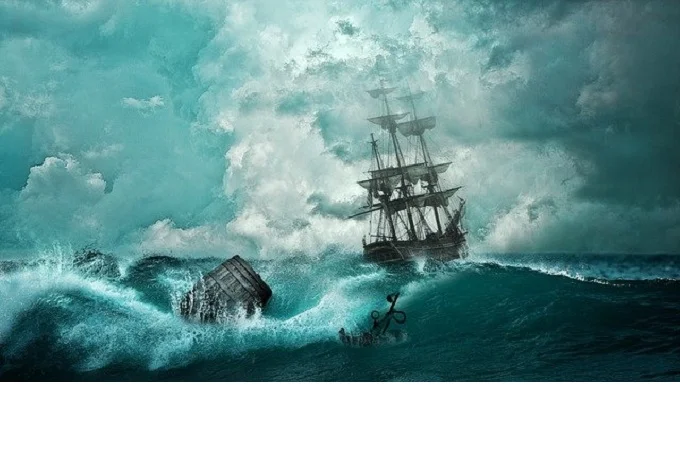Natural disasters are often only harmful. It is unlikely that anyone will rejoice in high waves, drought, or strong winds. It turns out that natural disasters can lead to the opening of areas previously inaccessible for study. This, in turn, allows new scientific discoveries to be made.
Traces of ancient people
In 2013, the village of Happisburgh, located on the east coast of the UK, was hit by a violent storm, eroding soil and exposing large sections of layered sediment. When the emergency services repaired the damage caused, they stumbled upon strange footprints that seemed similar to human ones, but they didn’t seem to be.
Having examined the traces, Archaeologists found that they belong to the ancestors of people who lived from 1 million to 780 thousand years ago. This find is valuable because fossils of early Pleistocene human ancestors are scarce in Europe and had not been found in Great Britain until then.
Prehistoric forest
In 2014, a series of especially powerful storms took place in Cardigan Bay in British Wales, which led to an outflow of water and exposed the remains of ancient trees that grew here more than 4.5 thousand years ago.
At that time, the sea level rose, which led to the flooding of the lands where the forest grew. In addition to trees, archaeologists have discovered an ancient wooden path that was built about 4 thousand years ago. It is believed that this was done to make it easier to move around the wetlands.
Coal Schooner Hull
In 2012, Hurricane Sandy hit the east coast of the United States, hitting Fire Island, New York. Sweeping away everything in its path, the hurricane exposed the hull of the coal schooner Bessie White, which ran aground in 1919 or 1922, as a result of which the crew was forced to abandon the ship.
No one was seriously injured, but Bessie White and the cargo were lost. Subsequently, most of the ship, including the masts and rigging, was removed, and then the ship, which had lost a lot of weight, was washed into the sea. And only after the hurricane the remains of the ship were thrown ashore.
Iron Age skeletons
The Iron Age refers to the ancient history of humankind, beginning in the 9th century BC and ending in the 1st century AD.
In 2012-2013, the Shetland Islands in Scotland experienced a series of storms that led to the collapse of a cliff in Channerwick. After the storm, researchers discovered several burials with skeletons dating back to 2000 years ago.
Alas, a storm prevented the discovery of the find in more detail, which caused the further collapse of the rock, leading to the remains’ reburial.
Neolithic city
In 1850, the Orkney Islands, located in northern Scotland, were hit by a violent storm that exposed a large hill. It turned out that the hill was actually artificial and was an ancient city called “Skara Brae.” The construction of this settlement dates back, as it turned out, more than a century later, 3200-2200 BC. In 1868, excavations were stopped after archaeologists discovered four ancient houses.
In 1925, another storm damaged some of the previously excavated buildings. To preserve the historical monument, it was decided to build a rampart, standing in the way of high waves. Moreover, during the construction of the rampart, even more, ancient buildings were discovered.
Steamboat
In 2001, Missouri, USA, was hit by a severe drought that drove river levels to record lows. This led to the ship “Montana,” which was built in 1882 and was the largest ship ever to sail the Missouri River, appearing on the surface.
However, the ship did not sail for a long time and sank in 1884 due to an impact on an underwater tree, after which it disappeared for 128 years.
Treasure pots
In 2015, a storm hit Israel, which, among other things, touched the beach of Palmachim Beach National Park. Strong winds and waves washed away layers of mud and exposed ancient artifacts, among which were clay pots called dolia, which were 1.5 meters deep and were made, according to archaeologists, between the 4th and 6th centuries AD.
Most likely, the pots were used as underground storage. The scientists found several items in the pots, including a small flask of oil, fragments of a saucepan, and an incense pipe.
Mayan hieroglyphs
In August 2001, a storm hit Guatemala, revealing a stone staircase previously hidden by centuries of sediment. Moreover, it was an unusual staircase covered with hieroglyphs, which caused a wide discussion among archaeologists, Mayanists, and other scientists.
The thing is that the inscriptions on the stairs told about a slightly different course in the history of the Mayan people who lived in this area.
The skeleton of an unusual whale
As we said earlier, Hurricane Sandy hit the United States in 2012. It covered vast areas, including the state of Florida, causing coastal erosion in Volusia County. A couple from Orlando, strolling along the beach, discovered the remains of the skeleton of an unusual whale.
And it was not a common whale: it was the beaked whale Gervais, a member of a group of beaked whales so little known and mystified that we are still finding new species even today.
Unexploded shells from World War II
The echo of the long past World War II is still heard, and now and then,, unexploded shells are found all over the planet. In 2012, after Hurricane Sandy, two unexploded ordnance were found on the coast of New Jersey.
And in 2014, after the last storm, an unexploded bomb of the same period was thrown onto the beach in the British county of Devon. And although all these findings, according to the results of the surveys, did not pose a threat, it is possible that if they had not been washed ashore, they could have run into ships.
